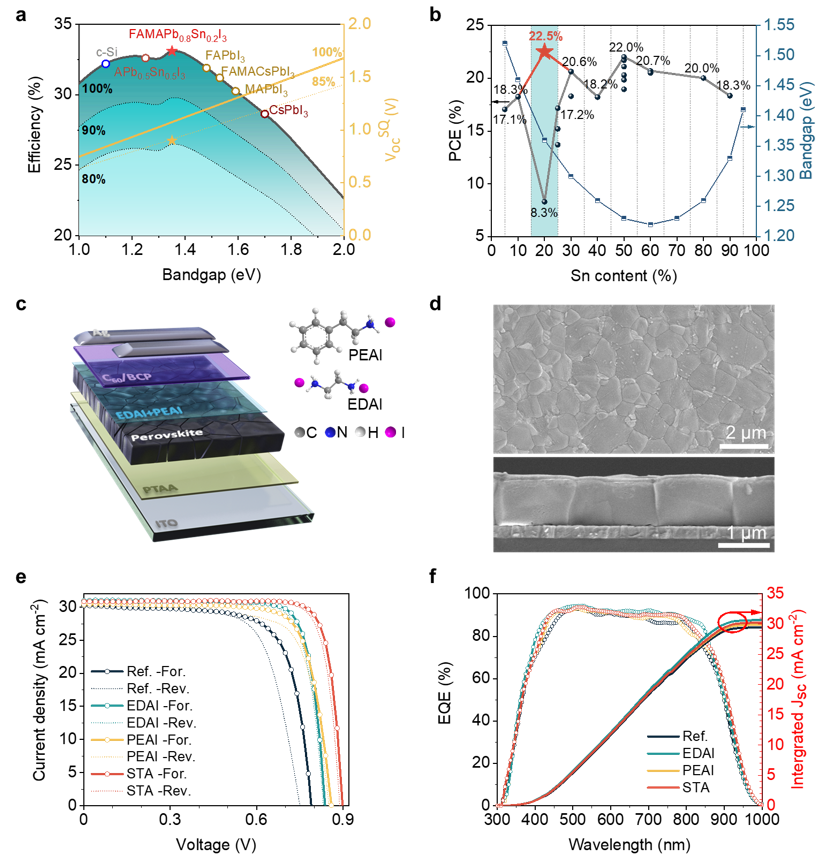
A recent study published in Advanced Materials reports a new solution to tackle bimetallic traps in high-efficiency perovskite solar cell (PSC) by applying anchoring strategy to get a record power conversion efficiency (PCE) of 22.51%, among the reported ideal bandgap PSCs.
The work was done by researchers with the Institute of Solid State Physics, Hefei Institutes of Physical Science (HFIPS), Chinese Academy of Sciences (CAS).
Bandgap of Pb-based perovskite materials normally ranges from 1.5 eV to 1.7 eV. However, according to Shockley-Queisser (S-Q) model, calculated and proposed by William Shockley and Hans Queisser in 1961, power conversion efficiency will reach the highest point when bandgap is at 1.33 eV.
Thinking of that, researchers try to lower bandgap to the value of 1.33 eV for theoretically the highest PCE via partially or entirely replacing Pb with Sn.
In fact, adding Sn directly up to 20% without any doping, the bandgap did fall to around 1.33 eV. But 20% Sn brought new problem of a massive open-circuit voltage loss.
"For the voltage loss, the bimetallic traps take the credit," explained PAN Xu who led the study and a researcher specialized in perovskite solar cells for years at HFIPS.
The bimetallic traps are actually caused by the most dramatical energetic and crystal structure turbulence, which PAN’s team decided to adopt targeting anchor strategy to hinder.
They firstly synthesized a Br-free lead-tin perovskite material with bandgap of 1.33 eV. Then they established the anchoring strategy that phenethylammonium iodide and ethylenediamine diiodide were introduced as "co-modifier" to selectively anchor with Pb- and Sn-related active site and then they "passivate bimetallic traps", according to the team.
Furthermore, energetic depth specificity of Pb- and Sn-related traps also clearly proved in the study the selectivity mechanism of molecular oriented anchor passivation.
After they adopted the strategy, the team was surprised to see a great improvement in open-circuit voltage from 0.79 V to 0.90V. So did the conversion efficiency reaching its record of 22.51%.
"Our work, I think, may shed light on metal dual-source defects in lead-tin perovskite solar cells." Said PAN who is expecting their work could offer useful passivation mechanism for responding to bimetallic traps.
This work was supported by the National Key R&D Project of China, the Science Funds of Distinguished Young Scholars of Anhui Province.

Figure 1. (a) S-Q limit efficiencies and VOC of different compositions; (b) Summary of recent works of LTPSCs and the bandgap variation versus Sn content ratio (blue line); (c) Diagram of device structure, inserted graph is chemical structure of anchor molecules; (d) Surface-view and cross-sectional SEM images after STA treatment; (e) Forward and reverse scan for J-V curves of the reference, EDAI, PEAI and STA device; (f) EQE plots and derived integrated JSC of the reference, EDAI, PEAI and STA device. (Image by YE Jiajiu)

Figure 2. DFT calculation of energetic depth of VAPb (a) and VASn (b), respectively; (c) TAS plots of the reference, EDAI, PEAI and STA. (Image by YE Jiajiu)